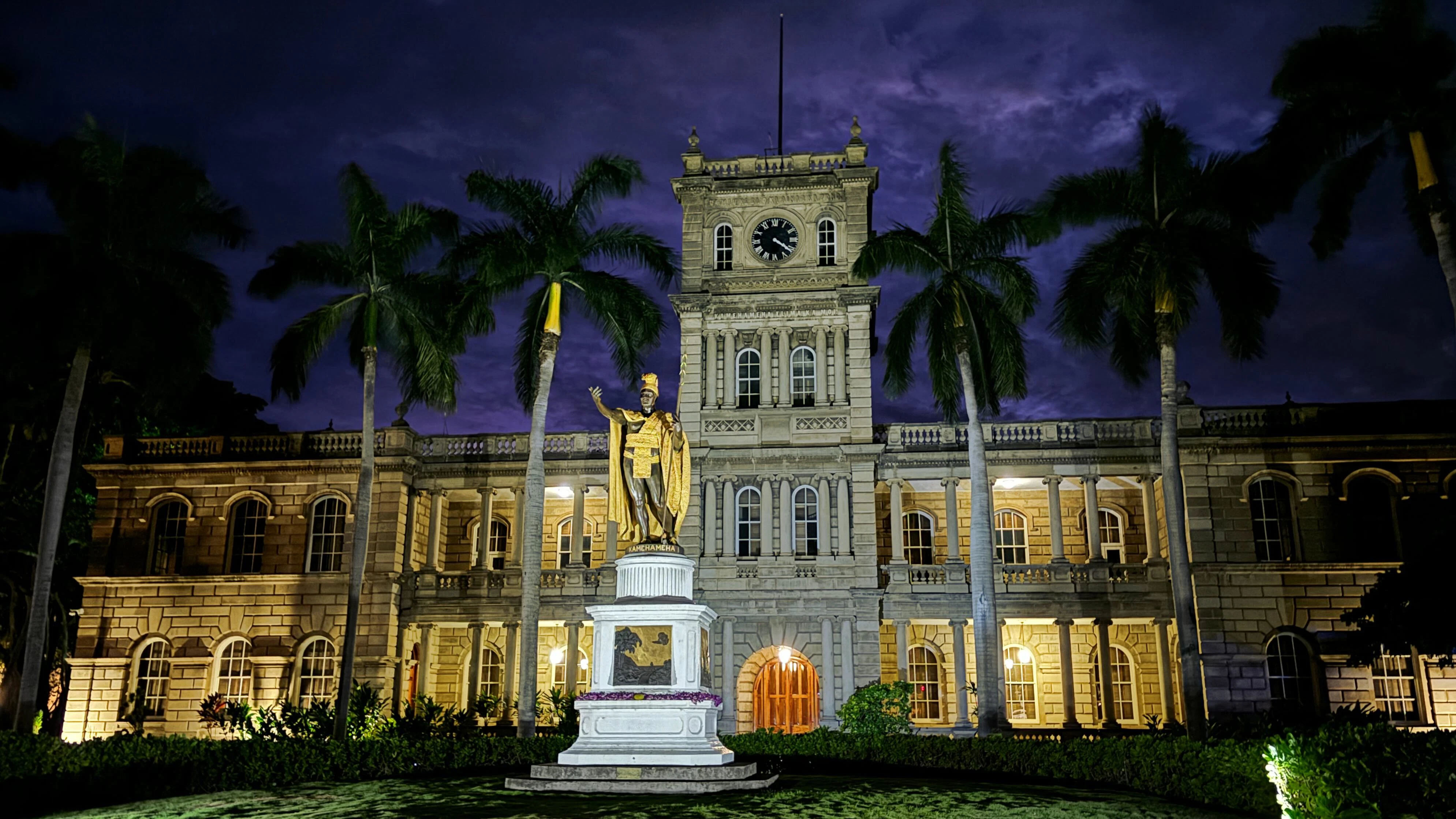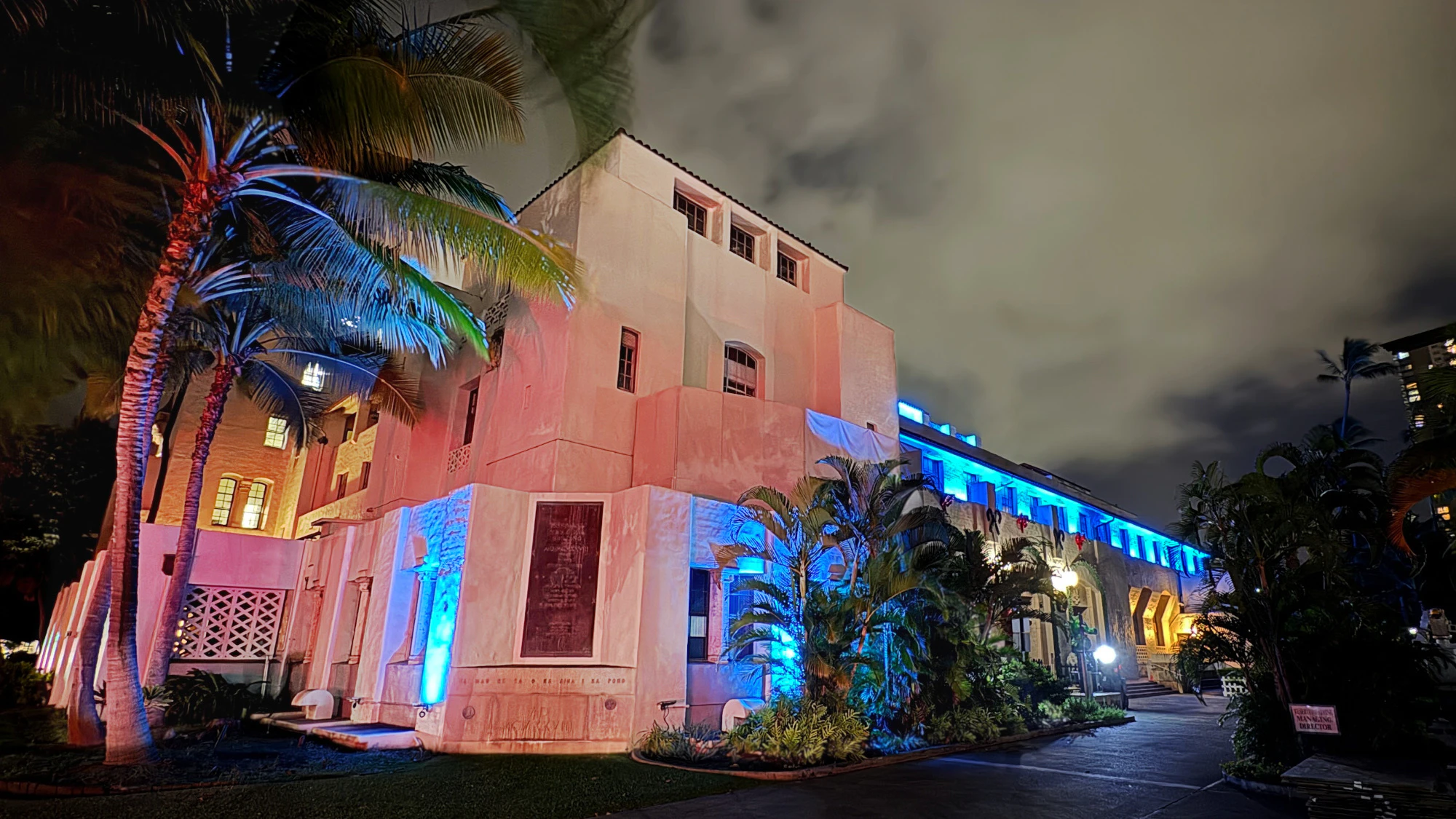Lot Kapuāiwa Kalanikupuapaikalaninui Kalanimakua Ali‘iōlani, grandson of King Kamehameha I, ascended the throne in 1863 following the death of his brother. As King Kamehameha V, he dedicated his reign to strengthening the Hawaiian Kingdom, preserving its sovereignty, uplifting its people, and bolstering its economy.
At the time, Hawaii’s government offices were scattered throughout Honolulu, making administration difficult. By 1866, the need for a centralized government building was clear. Although the legislature appropriated funds toward building a new palace and a new government building, delays shifted priorities. The plans for a palace were repurposed to construct the government building instead.
As Kamehameha V was a proud member of the Hawaiian Lodge of Free and Accepted Masons of Honolulu, construction of the new government building began on February 19, 1872 with the laying of the cornerstone with full Masonic rites. Sadly, the King would not live to see its completion. In honor of his vision and legacy, the structure was named Ali‘iōlani Hale, the house of Heavenly Kings, by King Kalākaua.
Upon its completion in 1874, the massive concrete structure was among the grandest and most imposing ever built in Hawai‘i. The building housed the legislature, the judiciary, the law library, and the first National Museum in the Kingdom. Over decades, it became the backdrop for defining moments in Hawaiian history. Standing silently in the center of town, it oversaw the Wilcox insurrection, the overthrow of the monarchy, and landmark trials such as the Myles Fukunaga and the Thalia Massie cases. It even faced demolition in the 1930s to make way for a new Judiciary Building. Fortunately, it was preserved for its historical significance, and the stately building remained a symbol of Hawaii’s legal and cultural heritage.
Today in Ali‘iōlani Hale, you will find the Supreme Court of the State of Hawai‘i, a law library, the court administration offices, and the Judiciary History Center. Having just celebrated its 150th birthday, the building serves a monument to the evolution of law in the Hawaiian Islands.
Beyond its architectural grandeur and historical legacy, Ali‘iōlani Hale still carries the emotional residue of the past and the people who walked its halls. Some people believe lingering energies like these echo through time, creating a psychic imprint.
Over a century and a half, this grand building has witnessed political struggles, passionate testimonies, and life-altering decisions. These emotional extremes don’t simply fade away, they saturate the environment, leaving behind a subtle feeling like an ionic charge that some individuals can still sense.
At one time, we were privileged enough to host evening programs inside Ali‘iōlani Hale. We’ve been told that inexplicable events are common in the building: eerie sounds and whispers, unexplained shadows, and the like. We wondered if the psychic imprint of the past is affecting the present. We intended to explore and attempt to capture the metaphysical residue of more than a hundred years of intense and often overwhelming emotions.
On a sunny summer afternoon, my wife and I arrived to fill out the application and make arrangements for our event. We passed through the security checkpoint and waited for our meeting in the rotunda, but my wife had to step away for a bit. The executive director of the Judiciary History Center met me near the museum. I followed him to his office outside the main doors at the end of the Diamond Head lānai. My wife called me, and I explained where we were, and she came to meet us in the office.
When she arrived, she looked very confused. Her eyes darted around the room filled with books, and then settled on me and the executive director standing there.
“Where is everyone?” she asked.
I had no idea who she was talking about since the director and I were the only people in the office, “Where is who?”
“When you answered, it sounded like there were dozens of people all around you. It didn’t even take me a whole minute to get here.”
The director looked as puzzled as I felt, “No one was here, it’s just the two of us.”
My wife rubbed the chicken skin on her arms and explained, “I kept asking ‘what?’ because I couldn’t hear you. It sounded like so many people were talking and trying to talk over each other. It wasn’t traffic or mechanical sounds, it was people!”
She smiled at the oddity of it, but was sad that she didn’t think right away to try to record the sounds. We all chuckled a bit and then continued our business. Just another funny occurrence in Ali‘iōlani Hale.
A few weeks later, we stood with our group outside the tall double doors of the Supreme Court building in the heat of a summer evening, just before sunset. A cool wind embraced us as we prepared to enter the building. The anticipation and excitement were tangible.
I sat the group in the courtroom museum, which was designed to look like it did in 1913. Our guests explored the room, taking in the atmosphere. Some took the opportunity to sit in the jury box, while others sat in the gallery.
There, I began to recount the details of the Massie case. It was full of dramatic twists and turns, high emotions, and inconsistencies in Thalia Massie’s story that she had been attacked by five local boys. After just three weeks, the trial ended abruptly with a deadlocked jury. Then, I explained the tragic aftermath in Massieʻs relatives kidnapped and murdered of one of the five defendants, young Joseph Kahahawai. During that time in Hawai‘i, racial tensions were at a boiling point, and the events surrounding the case exposed deep divisions within the community. They, in turn, were put on trial.
When I finished explaining the case, we walked to the back of the foyer. When they were all seated on the wooden benches that lined the walls, I instructed everyone to set their phones on video or audio recording. I asked several questions out loud, inviting any spirits that might be present to communicate with us. After I gave everyone a few moments to review their recordings, an older Hawaiian woman called me over.
She replayed her recording, and I heard my last question repeated, “If spirits from the Massie trial are present, please come forward and identify any living descendants in our group.”
Then, a second later, we heard a distinctly male voice say, “Nani.”
“My papa,” she said, “Always called me Nani. His name was John Clooney. He was Horace Ida’s arresting officer in the Massie trial. My papa said those boys were set up. They were never guilty of hurting that woman.”
We had done what we intended, to explore and capture the metaphysical residue of the intense emotions of one of Hawai‘i’s most notorious criminal cases.
Whether you believe in the metaphysical or not, it’s hard to stand inside Aliʻiolani Hale without sensing the weight of its past. A quiet, almost unspoken energy in its halls and courtrooms suggests the building remembers more than just its physical history.





